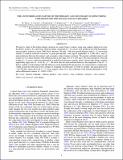| dc.contributor.author | Borkovits, T. | |
| dc.contributor.author | Csizmadia, Sz. | |
| dc.contributor.author | Kalomeni, B. | |
| dc.contributor.author | Tran, Ky-Anh | |
| dc.contributor.author | Levine, Alan M | |
| dc.contributor.author | Rappaport, Saul A | |
| dc.date.accessioned | 2015-01-29T18:15:39Z | |
| dc.date.available | 2015-01-29T18:15:39Z | |
| dc.date.issued | 2013-08 | |
| dc.date.submitted | 2013-05 | |
| dc.identifier.issn | 0004-637X | |
| dc.identifier.issn | 1538-4357 | |
| dc.identifier.uri | http://hdl.handle.net/1721.1/93200 | |
| dc.description.abstract | We report a study of the eclipse timing variations in contact binary systems, using long-cadence lightcurves from the Kepler archive. As a first step, observed minus calculated (O – C) curves were produced for both the primary and secondary eclipses of some 2000 Kepler binaries. We find ~390 short-period binaries with O – C curves that exhibit (1) random walk-like variations or quasi-periodicities, with typical amplitudes of ±200-300 s, and (2) anticorrelations between the primary and secondary eclipse timing variations. We present a detailed analysis and results for 32 of these binaries with orbital periods in the range of 0.35 ± 0.05 days. The anticorrelations observed in their O – C curves cannot be explained by a model involving mass transfer, which, among other things, requires implausibly high rates of ~0.01 M[subscript ☉] yr[superscript –1]. We show that the anticorrelated behavior, the amplitude of the O – C delays, and the overall random walk-like behavior can be explained by the presence of a starspot that is continuously visible around the orbit and slowly changes its longitude on timescales of weeks to months. The quasi-periods of ~50-200 days observed in the O – C curves suggest values for k, the coefficient of the latitude dependence of the stellar differential rotation, of ~0.003–0.013. | en_US |
| dc.description.sponsorship | Szombathely (Hungary) (Agreement S-11-1027) | en_US |
| dc.language.iso | en_US | |
| dc.publisher | IOP Publishing | en_US |
| dc.relation.isversionof | http://dx.doi.org/10.1088/0004-637x/774/1/81 | en_US |
| dc.rights | Article is made available in accordance with the publisher's policy and may be subject to US copyright law. Please refer to the publisher's site for terms of use. | en_US |
| dc.source | American Astronomical Society | en_US |
| dc.title | THE ANTICORRELATED NATURE OF THE PRIMARY AND SECONDARY ECLIPSE TIMING VARIATIONS FOR THE KEPLER CONTACT BINARIES | en_US |
| dc.type | Article | en_US |
| dc.identifier.citation | Tran, K., A. Levine, S. Rappaport, T. Borkovits, Sz. Csizmadia, and B. Kalomeni. “ THE ANTICORRELATED NATURE OF THE PRIMARY AND SECONDARY ECLIPSE TIMING VARIATIONS FOR THE KEPLER CONTACT BINARIES .” The Astrophysical Journal 774, no. 1 (August 19, 2013): 81. © 2013 The American Astronomical Society | en_US |
| dc.contributor.department | Massachusetts Institute of Technology. Department of Physics | en_US |
| dc.contributor.department | MIT Kavli Institute for Astrophysics and Space Research | en_US |
| dc.contributor.mitauthor | Levine, Alan M. | en_US |
| dc.contributor.mitauthor | Rappaport, Saul A. | en_US |
| dc.contributor.mitauthor | Tran, K. | en_US |
| dc.relation.journal | Astrophysical Journal | en_US |
| dc.eprint.version | Final published version | en_US |
| dc.type.uri | http://purl.org/eprint/type/JournalArticle | en_US |
| eprint.status | http://purl.org/eprint/status/PeerReviewed | en_US |
| dspace.orderedauthors | Tran, K.; Levine, A.; Rappaport, S.; Borkovits, T.; Csizmadia, Sz.; Kalomeni, B. | en_US |
| dc.identifier.orcid | https://orcid.org/0000-0003-3182-5569 | |
| mit.license | PUBLISHER_POLICY | en_US |
| mit.metadata.status | Complete | |
